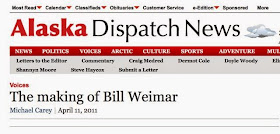Melisa Green, posted a link to this New York Daily News article at Bent Alaska Facebook page.
"The Daily News exclusively learned the latest transgender person to make a splash in the world of mainstream television is Scott Turner Schofield, who has joined the cast of CBS’ long-running soap opera “The Bold and the Beautiful” and will make his first appearance May 8 — bringing a real-life verve to an already controversial storyline.
Schofield is making his TV acting debut on the Emmy Award-winning daytime series, after winning raves in regional theater throughout the years."
Thanks to writing a blog, I can tell you when I first met Scott - January 2, 2010. He was at Out North as a visiting performer and introduced the Under 30 production. I was so taken by how he held himself, spoke, what he said, and his warmth, that I mentioned him with a shaky photo in the post I did of Under 30 that he introduced that night.
In July that year, Scott had just become the artistic
 |
| Scott Turner Schofield at Out North Anchorage July 2010 |
"On the right is Scott Schofield, Out North's new artistic director after the performance. Preparation for the performance began just as he arrived at OutNorth. His introduction Wednesday was a pleasure to listen to. His words were good, his delivery fluent, and he effortlessly rotated to acknowledge the audience members sitting behind him on the stage. "It was only later that we saw him perform "Two truths and a Lie." and even later when he came back to perform his resurrection piece.
I try not to say "I told you so" but in this case I'm delighted to. And I have the blog posts to prove it.
And while the Supreme Court uses the law to argue their personal takes on the issue of same-sex marriage and the Anchorage mayor's race is once again discussing LGBT rights, I think it's important for as many people as possible to watch Scott Turner Schofield's Ted Talk.
My fantasy is that someone gets Jim Minnery and Amy Demboski to watch this Ted Talk until they get it. Maybe they can dig deep enough into themselves - the way Scott did - to discover why LGBT folks make them so crazy. Those of you who didn't have the pleasure of seeing Scott while he was in Anchorage, this will help show you why I was so impressed.
*Feedburner note: Feedburner relays new messages to subscribers and blogrolls so that they know there is a new post. Usually it works fine. But too often it doesn't. Sometimes it's clear that there is lengthy code in something I've copied from somewhere else and if I get rid of it, Feedburner works. Sometimes it's just mysterious. Like this post. I posted it yesterday, but it didn't get to blogrolls. I posted it again last night. This morning it still wasn't on blogrolls. So I did it again this morning and it worked. The only people this might irritate, besides me, are subscribers who actually do get notified several times for the same post. My apologies to them. This is why I'm writing this here. It's a particular problem when I'm posting something that's time sensitive - like election results, or a note about an event coming up soon.



































